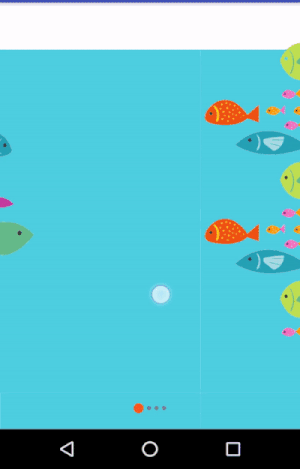OffsetAnimator
OffsetAnimator lets animate objects basing on touchevents, so users can be engaged in an animation process.
Usage
Add the library to your project:
- Add it in your root build.gradle at the end of repositories:
allprojects {
repositories {
...
maven {
url 'https://jitpack.io'
}
}
}
- Add the dependency:
dependencies {
compile 'com.github.russelarms:offsetanimator:1.0.2'
}
Requirements
Min sdk version is 11. The library doesn't have any transitive dependencies.
Tutorial
Scene
To create viewpager-based animation you should bind a scene to position updates:
ViewPagerAnimatorAdapter animatorAdapter = new ViewPagerAnimatorAdapter(scene.getScene());
viewPager.addOnPageChangeListener(new ViewPager.SimpleOnPageChangeListener() {
@Override
public void onPageScrolled(int position, float positionOffset, int positionOffsetPixels) {
super.onPageScrolled(position, positionOffset, positionOffsetPixels);
animatorAdapter.onPageScrolled(position, positionOffset);
}
}
);
Then create a scene instance and pass it a root view and an initializer function:
Scene.create(getRootView(), () -> initSteps());
Scripting
Script desired animation like this:
private void initSteps() {
scene.page(0).step(0)
.createAnimation(ocean.getY(), ocean.getY() - convertDIPToPixels(getContext(), 120))
.setStartThreshold(0.5f)
.setDuration(0.8f)
.setInterpolator(new DecelerateInterpolator())
.setListener(value -> ocean.setY(value));
}
A single page is taken as 1.0f. So duration 0.5f is a half of a distance.
Lazy initialization
It is not always convenient to specify exact view positions after some script done, so we can pass a lazy initializer. In this example animator will be initialized only on page 3 with corresponding coordinates:
scene.page(3).step(3)
.createAnimation(() -> AnimatorFactory.createAnimator(fishLeftBottom.getY(), fishLeftBottom.getY() + screenDimensions.y / 2))
.setDuration(0.5f)
.setListener(value -> fishLeftBottom.setY(value));
Here's how to set the rotation:
scene.page(2).step(2)
.createAnimation(0, 90)
.setDuration(0.25f)
.setListener(value -> submarine.setRotation(value));
Interpolators
We can specify an interpolator (from android.view.animation). The library ships its own SpringInterpolator:
scene.page(1).step(0)
.createAnimation(1926, 1032)
.setInterpolator(new SpringInterpolator(0.8f))
.setListener(value -> submarine.setY(value));
Arc animations
Create arc animation:
scene.page(2).step(1)
.createAnimation(() -> AnimatorFactory.createArcAnimator(submarine,
Utils.centerX(submarine),
convertDIPToPixels(getContext(), 48),
submarine.getX() + submarine.getWidth() / 2,
Utils.centerY(submarine),
180f, Side.RIGHT))
.setStartThreshold(0.5f)
.setDuration(0.5f);
While standard OffsetAnimator requires user to set listeners and update fields by hand, arc animator doesn't need listener: it assigns value implicitly.
Inheritance
OffsetAnimator is open to be inherited:
public class AnotherOffsetAnimator extends OffsetAnimator {
public AnotherOffsetAnimator(float x1, float x2) {
super(x1, x2);
}
@Override
public void animate(float position) {
super.animate(position);
}
}
and to be used with a scene:
scene.page(3).step(1)
.createAnimation(() -> new AnotherOffsetAnimator(fishRight.getX(), fishRight.getX() + convertDIPToPixels(getContext(), 160)))
.setDuration(0.5f)
.setListener(value -> fishRight.setX(value));
License
OffsetAnimator is available under the MIT license. See the LICENSE file for more info. The library uses some code from https://github.com/asyl/ArcAnimator for arc animations.
The submarine and the fish images picked from freepik.com: Designed by Freepik Background vector created by Freepik
Copyright 2017 russelarms.
